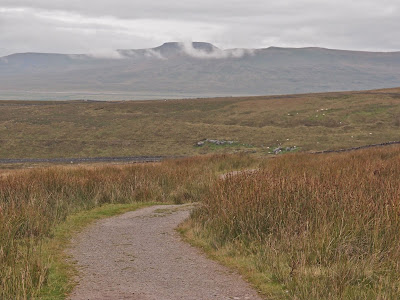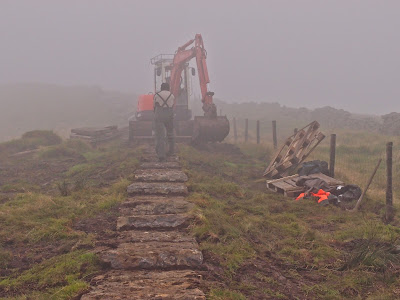 |
| Pen-y-Ghent |
I was due to drive down to London to see our daughter and granddaughter and then collect a new car that I had bought online. It seemed a waste of a journey without an expedition en route so I decided it was time to attempt the Yorkshire Three Peaks challenge. The forecast was a bit mixed but I drove down in the previous afternoon and arrived in Horton-in-Ribblesdale at 6 p.m. on a beautiful evening with Pen-y-Ghent beckoning in the evening sunlight. I arrived at the Holme Farm campsite and found the owner who had just come out of a hospital after a major operation and was recuperating in authentic Yorkshire style by returning to work immediately. He welcomed me to the site and told me to put up my tent and pay later when he would be down at the reception marquee which was adorned with all sorts of paraphernalia. A campsite on a flat field with cut grass and facilities has its advantages over my more usual wild camps in remote locations.
I had a lazy walk around the village in the evening sun before going into the Golden Lion for a pub meal and a couple of pints of Timothy Taylor, one of my favourite beers. It was Ukraine versus England live on the television and the pub soon filled with locals and visitors. The barmaid served everyone with a courtesy, zest and efficiency that was exceptional. The football match was not that entertaining so I bailed out at halftime to get an early night. I planned to start at 7:30am as I was feeling fairly fit and anticipated getting well under the 12-hour challenge. I had prepared a schedule for a 10-hour round after consulting the 3 Peaks Forum but then discovered that the race record was less than 3 hours by Geoff Norman in 1974. He had only beaten me by 20 minutes in the Snowdon marathon 25 years ago, so I figured I could manage the 10 hours.
 |
| Horton in Ribblesdale church and Pen-y-Ghent |
 |
| Pen-y-Ghent path into the cloud |
 |
| Pen-y-Ghent looms out of the cloud |
 |
| Looking across to Ingleborough from the Pan-y-Ghent descent |
 |
| Ribblehead Viaduct over Blea Moor |
 |
| The most famous signal box in Britain? |
 |
| Settle to Carlisle railway with Ingleborough in the background |
 |
| Friendly Yorkshire Red Grouse on Whernside ascent |
 |
| Limestone pavement being laid below Whernside summit ridge |
 |
| Whernside trig point |
 |
| Ascent of Ingleborough |
 |
| Yorkshire Grannies on Ingleborough |
Wednesday, 11 September 2013
Ascent: 1525 metes
Distance: 39 kilometres
Time: 7 hours 41 minutes
Pen-y-Ghent 694m 57mins
Long Mires 1hr 53mins
Aqueduct 3hrs 31mins
Whernside 732m 4hrs 17mins
Old Hill Inn 5hrs 14mins
Ingleborough 724m 6hrs 13mins
Horton in Ribblesdale cafe 7hrs 41mins
After a rare dry night in the tent, I was awoken at 5am by a party of campers setting out for their Three Peaks walk. It was still dark and I dozed off again but by 6am I was awake and thinking that perhaps I should start earlier than intended as the forecast was for rain in the afternoon. I had a snack, packed the tent and camping gear into the car and managed a 7am start from the campsite. It is next to the cafe which records Three Peaks rounds but the cafe was closed at this early hour. Pen-y-Ghent was still visible but ominous grey clouds were heading in. I assumed that it would be a mostly wet day and thought it would be a bonus to climb Pen-y-Ghent in the dry.
I downloaded the split times for a 10-hour round from Mac.hawk's email in response to my request to the 3 peaks forum. Walking past Horton in Ribblesdale's Ofsted-rated 'Outstanding Primary School' I soon reached the path which climbed through the bright green fields decorated with sheep and limestone blocks. The final 200 metres of the climb up Pen-y-Ghent is a steep staircase up to the scarp edge of the hill. I was slightly surprised that I had broken the hour for the ascent and I was 23 minutes ahead of the split time for the 10-hour schedule. The summit was in cloud so I wasted no time in starting the next leg of the walk.
The descent was quick and easy down a muddy path from the summit at first and then an excellent path which encouraged me to run as I began to think that a 9-hour round was possible. The paths continued to be well made with an excellent new section at Whitber Hill which includes some fine dry stane dyking in progress. By Long Mires, I had made another 10 minutes on the schedule and at Nether Lodge I had caught the four walkers who had made the 5 a.m. start from the campsite. The next section crossed the river and then climbed up to Lodge Hall before a couple of kilometres along the road to the Ribblehead T junction. There was a car park here and another batch of walkers was setting out for Whernside. I was mesmerised by the approaching view of the Ribblehead Viaduct.
The Ribblehead viaduct across Blea Moor is one of the must-visit places for steam locomotive photographers but this was the first time I had been up close. A three-car diesel unit grumbled past having no presence whatsoever. The Blea Moor signal box is one of the most photographed in Britain set a mile or so before the eponymous tunnel. My pace was not slowing and I overhauled a number of walkers as the gradient increased. A lone female runner appeared out of the mist on her descent from Whernside. In the still air, there were echoes of heavy machinery at work on the hillside.
The summit of Whernside was in the cloud and I came across a digger and two men laying vast limestone slabs on the boggy ground leading to the summit. There had been a staircase of limestone slabs up to the summit ridge and the men were surrounded by stacks of slabs that had presumably been helicoptered in. As a stairway to heaven, it was a good attempt. Again the summit was in the cloud and there was no one around to occupy the generous shelters which overwhelmed the trig point.
I passed five people on their ascent from the south during my descent to Brunscar which is helped by more man-made limestone pavements. As I continued across the grazing land I was charged by a cow with a calf. I met another two of the 5 a.m. starts before I called in at Old Hill Inn to fill my water bottle and then rescued some lunch and waterproofs from my rucksack as the rain began to fall steadily.
The path from here up to Braithwaite Wife Hole is through more grazings and at times the trail was not immediately obvious. Beyond is the famous Ingleborough staircase which steepens as it climbs viciously towards the summit. I was on a charge by this time realising that I was now on a schedule of 8 hours. From 500 metres the hill was in the clouds so I had to sense my way across the plateau which is festooned with random cairns to the summit. There are four seating areas circling the summit, two of which were occupied by a bevvy of Yorkshire grannies. I am deeply fond of Yorkshire grannies but they are formidable people; I know as I had one from Denby Dale. "Would you like us to push up and let you in luv," sounded like a deal I should give a miss, although I suppose they are my generation nowadays. I took a photo of them instead and they wished me good luck as I headed down into the mist.
Initially, I was disorientated as I escaped the grannies and could not refind the path so I had to retrieve my compass and take a bearing to find the route down. There is a long descent to Horton over wet muddy ground which is studded with smooth slippy limestone blocks. It meant the descent had to be more cautious than I would like but I seemed to be well ahead of 8 hours so I walked most of the way apart from the last mile into Horton. I was back at the campsite by 2:45pm for a total time of 7 hours 41 minutes. I called in at the cafe to see if I could get a certificate but as I had not posted a card into the cafe in the morning this was not possible. This was a bit of an anticlimax to a day that had gone far better than I had expected.
I changed alongside the car and then the really difficult part of the day began. It took 2 hours to reach the M1 via Skipton and Bradford. The West Yorkshire conurbation was gridlocked with traffic in the late afternoon. I had intended to travel down to London via the M6 but I had been warned by a fellow walker that it was cluttered with roadworks. I made it down the M1 from Wakefield to London in two and a half hours and then it took another hour and fifteen minutes to get across London to the south side. The Three Peaks was a lot easier than the driving nightmare that followed but I arrived by 10pm feeling quite relaxed and not at all stiff after a long day on the Yorkshire hills.
 |
| Real limestone pavements on the final descent to Horton in Ribblesdale |

No comments:
Post a Comment
thanks